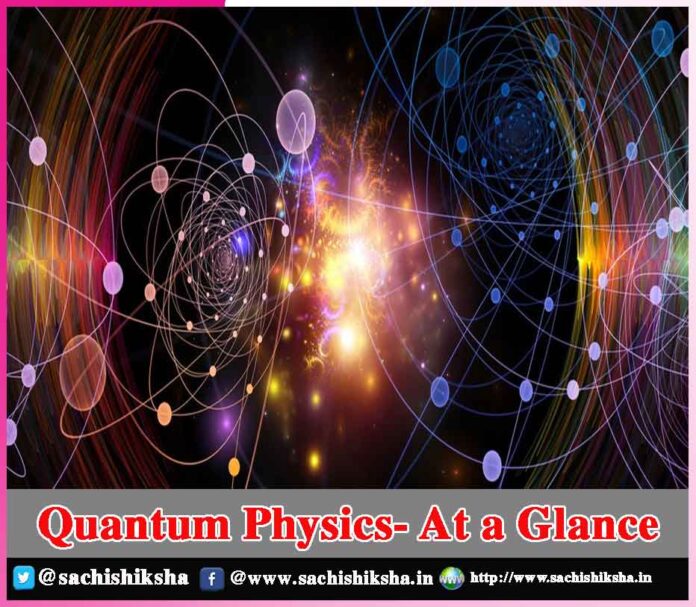Quantum Physics- At a Glance
Table of Contents
Since the earliest days of scientific inquiry,
scientists have been fascinated with learning about the basic building blocks of matter. At one time, the scientists thought that they had solved the mystery when atoms were theorized and finally discovered. Surely there couldn’t be anything smaller than the atom. It didn’t take scientists long to begin theorizing about what might exist inside atoms.
Over the past century, the scientists have come up with the fascinating theories about how things that make up atoms work. Quantum mechanics is a fundamental theory in physics that provides a description of the physical properties of nature at the scale of atoms and subatomic particles. This field of study is known as quantum physics sometimes also known as quantum mechanics. Often this science sounds more like science fiction than regular science.
Also Read :-
- SPIRITUAL-CONFIDENCE!!
- Positive Attitude to Life
- Esteemed Qualities of Devotee
- Positive Attitude of Life
Studying matter at the subatomic level is not easy.

According to Planck, a quantum is the smallest possible amount of energy. A quantum of light, for example, is known as photon. Planck won the Nobel Prize in Physics in 1918 for his theory. Other prominent scientists, including Albert Einstein, Niels Bohr, and Werner Heisenberg, added to Planck’s work to develop quantum physics in the following decades. The theories that quantum physicists have developed over the years can be difficult to understand for even the most brilliant scientists. For this reason, we’ll take a look at the most basic aspects of quantum physics.
Wave Particle Duality
refers to the fundamental property of matter where at one moment it appears like a ‘wave’ and yet at another moment it acts like a ‘particle’. In simple terms, a particle is a small piece of anything. Wave means an energy moving from one place to another place i.e. energy goes into wave form without any matter. If we ask where a particle is, we can easily tell where it is, it can be easily said it is here or there and how far away, or it is square or round. But how can we tell where an object is in the wave, it can be anywhere. In particle form, the object is moving towards a particular place or in a certain direction. Quantum level states that an electron or proton can be both an object and a wave. The double slit experiment shows how that is possible.
Imagine a wall with two slits in it. Imagine throwing tennis balls at the wall, some will bounce off the wall but some will travel through the slits. If there is another wall behind the first, the tennis ball that have travelled through the slits will hit it. If you mark all the spots where a ball has hit the second wall, you will see two strips of marks roughly the same shape as the slits. Now let us move into the quantum realm, now imagine electrons firing at a wall with two slits but one of those slits blocked for now. You can see that some of the electrons go through the open slit and hit the second wall like tennis ball did. The spot’s electrons arrive at, form a strip roughly the same shape as the slit.
Sofar everything is clear, now open the second slit and fire electrons. You did expect two rectangular strips on the second wall like it happened with tennis balls, but it was observed that the second wall had multiple strips. The scientists were confused with this outcome and finally realized that electron is not acting like a particle, but as a wave form. That is the electron leaving the electron gun becomes a single wave before the slits and multiple waves after crossing the slit.
Super positioning
is a very interesting thing. To understand super positioning let us first get inside an atom. The atom is made of electrons, protons and neutrons and that electrons orbit around the nucleus. The nucleus is made up of protons and neutrons. The structure of an atom shows some interesting thing. For example, if nucleus is a small ball placed in the center of a cricket ground, then the boundary of the field is the path around which the electrons orbit. There is empty spaces between the nucleus and the electrons that surround it.
Here the electron does not orbit like a ball as we think but it orbits the nucleus like a cloud. The electron is orbiting extremely fast. It is not possible to say exactly where it is, it can be anywhere. If you suddenly touch your hand in one place it will be there, if you touch your hand other place it will be there too. Being in all places at the same time is called ‘super positioning’.
The third basic thing is Quantum Entanglement which is a bond between two particles. This is a phenomenon that occurs when two or more objects are connected in such a way that they can be thought of as a single system, even if they are very far apart. The state of one object in that system can’t be fully described without information on the state of the other object. Likewise, learning information about one object automatically tells you something about the other and vice versa.
The scientists also link this theory with the time of ‘Big Bang’. During the Big Bang maybe infinite number of universe were formed and everything may be entangled. That is, if one universe moves forward another may move backwards or something else. Einstein calls this theory ‘spooky action at a distance’ because information reaches faster than light even if one electron is left on the earth and another electron is placed on the mars. According to Einstein’s theory nothing can travel faster than light in this universe, he could not accept this as it violated his relativity theory.
Conclusion:
Though quantum physics continues to baffle our scientists it has created revolution in the field of science.
The creation of quantum physics has transformed our world. Computers, smart phones, sensors, LEDs, lasers, GPS, MRI scans etc.have beenthe product of quantum technology. Quantum mechanics was created to describe an abstract atomic world far removed from daily experience, its impact on our daily lives has become very important.













































